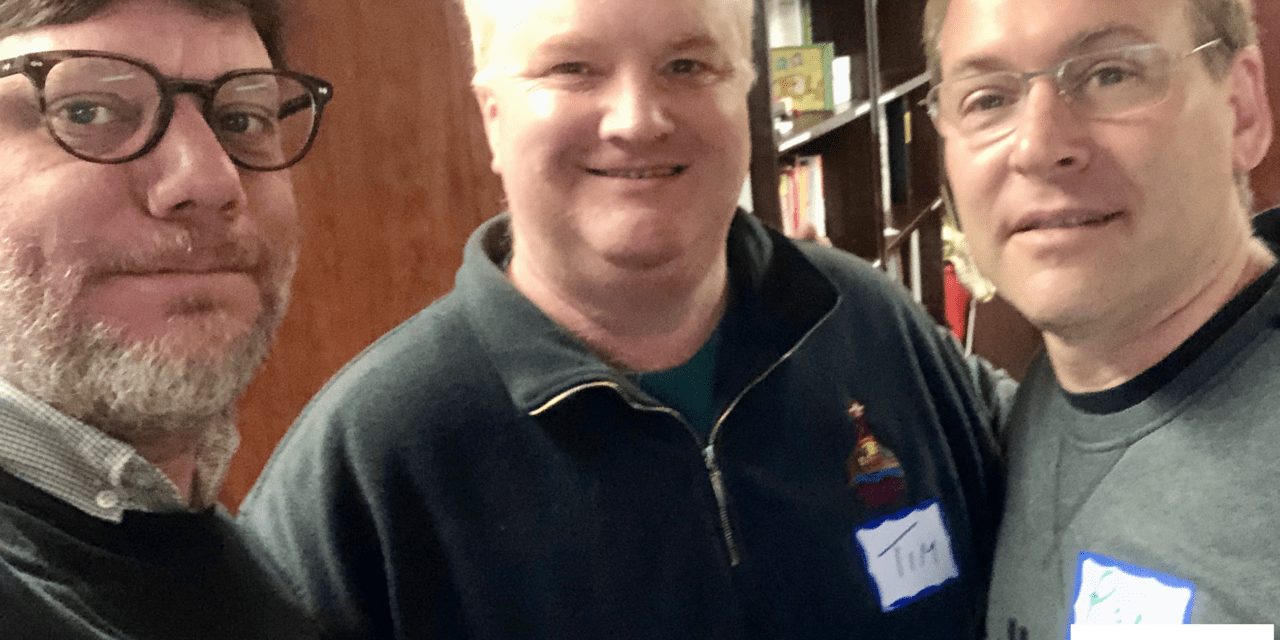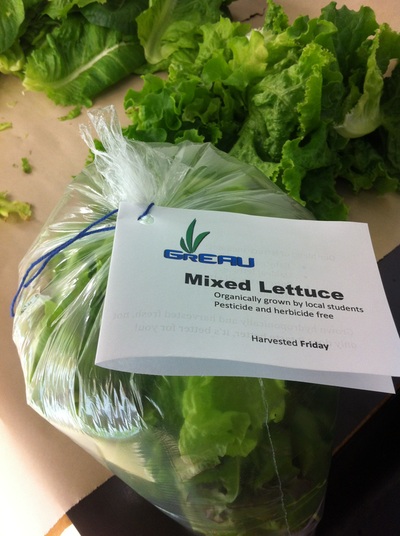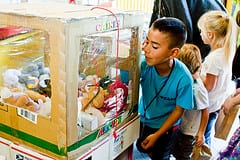On June 15th, I reached out to pedagogical consultants, Tim Foreman and Ron Turchyniak, whose dossiers are to help teachers and staff at Sir Wilfrid Laurier School Board (SWLSB) integrate educational technologies in the classroom. All this changed in March. Their jobs became all the more crucial as teachers shifted from classroom to online teaching amidst the Covid-19 pandemic. It is safe to say that Tim and Ron’s time was essential in getting educators online, and comfortable with using tech tools that would facilitate this shift in practice. Countless professional development sessions later, LEARN caught up with these two rock stars to chat about this transformational shift and how they we faring in this new “normal.”
Transcript
edited for readability
Chris Colley: Here we are again. We’re on our ShiftED conversation with educators.. Today, we have two consultants from Sir Wilfrid Laurier School Board. We have Tim (Foreman) and Ron (Turchyniak) who work as consultants and we’re having conversations with educators just to get an idea of how things are going out there. What’s the pulse from the shift that we’ve had to go on from face-to-face to more of an online learning environment. So, welcome you two guys. How’s it going over at Sir Wilfrid Laurier? How are you guys doing?
Tim: Well, thanks very much for the invitation. It’s busy, that’s for sure but we’re doing well so far I think.
Chris: How are you, Ron?
Ron: It’s been excellent. We’ve been getting a lot of emails and despite all the overload of emails, it’s been super.
Chris: Right on. Maybe just touch on… Tim – what what’s your role at the board? What do you consult in?
Tim: OK. Well, both Ron and I are educational technology consultants. So, our job was pretty simple until a few months ago, in the sense that our main focus was working with teachers to use technology effectively in class. We had some some major dossiers like the assistive technology portfolio but over the last couple of years one of the big thrusts that we have was with coding and robotics. So, we spent a lot of time doing that.
Chris: Ron, bring me back. Let’s go back before this all began. Before March 13th, what were you guys doing? I know it came so suddenly and we were all caught off guard but what were you guys up to before all this shutdown happened?
Ron: Yes, it was a big year because of all the – as Tim was mentioning earlier, about the coding and robotics dossier and bringing coding back into our schools – we give a lot of courses where a lot of the teachers came to the board office. We had a lot of funding from the government. So, we’re getting a lot of training to the teachers and our community of lead practitioners in our schools.We tried to make our coding and robotics lessons pertinent to the subject areas. We did a lot of training with groups of teachers and with our lead teachers. Which is now shifted to this online paradigm where we’re teaching a lot of teachers at the same time for various schools without everybody running to one location.
Chris: What was kind of the first weeks like when you guys first, when the shutdown first happened? I imagine that you guys must have been inundated with emails and requests and I don’t know how to do this, and I need help with that, and I got to go online…What were those first initial weeks like?
Ron: I would love to think back because I would remember, 3 in the morning, Tim was very nervous and so was I when we gave our first online training. It wasn’t any different for us than it was with the teachers. We were used to delivering in front of the group. So, from our point of view, Tim was texting me at 3 in the morning as he had a session the next day. We felt the nervousness also. And Tim, you remember that?
Tim: Oh, for sure. I mean my overriding sense of that is there’s just a hard stop as of the 13th of March, where we just stopped what we were doing. And really up until that time, we knew we were watching the news. We knew stuff is going to happen, there’s some stuff that’s happening, but I don’t think we had a sense of – I mean, I’m just talking for myself here – but I did not have a sense of the full scope of what was about to happen. So we stopped. Then the directives start coming from the government and we’re trying to make sense of that and we’re trying to figure out what our next step is going to be, right? And if you remember that first two-week period where the teachers were put on hold, that’s the time when we had to kick it into gear, in order to have something for the parents. I think we’ll probably talk about the learning backpack at some point in this ’cause Ron took the lead on that and it made, I think it made a big difference for our parents as we’ve been waiting to find out what was going to happen with the teachers.
Chris: Right. Yeah, those first couple weeks, eh, it was everything’s on pause. Kids are on vacation for two weeks. We’ll see what happens. It was very fluid at the time but things started to shift, right? These demands started to come in. So what were the huge demands on you guys when this first started? What were the kinds of requests that you were getting for support?
Ron: Well, I think our initial fear were the inequity. Do kids actually have access? Do teachers have access? How are we going to get information to everybody? I mean, to make it equitable? That was our initial fears. Do we have to use a phone? Do we have to send mail? Those are the biggest challenges for us to start. What does it all look like for families in their homes and how do we get that information to them? Especially if teachers beforehand were used to paper, pencil, smartboard, and email and they weren’t used to all this technology. So, that was their biggest challenge.
Chris: What were some of the technologies that you guys had at the forefront that were going to help you with this transition? What were you guys looking at at your board at Sir Wilfrid Laurier?
Tim: We had Zoom as our fallback communications platform. Zoom, we were using it for video conferencing sessions. I know I used it a little bit with connecting teachers to museums and stuff like that but all of a sudden this became like the main way that we’re going to communicate. Right off the bat…Initially, it was all still through an email. Ron, correct me if I’m here, but that’s that’s the way the teachers routinely or traditionally reached out to us. But when we started getting our head around the fact that we’re going to be doing this for a while, the Zoom connection became a really important tool and the usage of it just skyrocketed as I’m sure like all the other school boards as well.
Ron: The other thing too, not just from a hardware point of view and a software point of view, but Tim and I noticed too that a lot of the soft skills, the things that are not taught in classrooms, and teachers were not maybe getting in their formal education – I think our system is failing with respect to knowledge of the computer literacy. Because we’re getting bogged down on a lot of those issues. So let’s put teaching aside for a moment. The computer literacy part has been lacking with a lot of the kids and a lot of the staff. They know how to go on a computer but it’s those important things that not everybody gets or got a chance to learn during their schooling.
Chris: Ron, when you talk about soft skills, can you elaborate on that a bit? What are you talking about?
Ron: The things that are not taught in school. I would have to make a parallel. In the financial world, we don’t tell kids how to save money, or how to budget. That’s the kind of thing I’m talking about. The things that fall between the cracks in education. We work on the pedagogy but we don’t work on the mechanics. Microsoft Word is probably shown to the kids but using an Excel spreadsheet or all those little things –
Tim: – Like file management –
Ron: [unintelligible] It’s like digital citizenship. It’s not part of the curriculum so some of it falls between the cracks. It’s kind of the same thing.
Chris: They say it’s everybody’s job and nobody’s job. So it often gets neglected. And those simple things too. I guess it’s just assumed that these modern kids will know how to file, save files, and know how to manage folders. Yet, without that practice, or without showing, or getting them to do that on a regular basis, it kind of does fall through the cracks. So, how did your teachers adapt? I hear from you guys that it was overwhelming for everybody. The system got overwhelmed very quickly. How did your teachers slowly adapt as you were starting to just focus on the how-to’s of online.
Tim: I think the teachers reacted incredibly. I think that there was a misconception and it was, I thought, a very unfortunate choice of words when the government referred to teachers as being on vacation because the teachers that I knew and the teachers that Ron knew certainly were not considering it a vacation. They were at home, already thinking about how they’re going to be able to reach out to their students. I think that we were pleasantly surprised with the level of engagement that the teachers showed as we started offering professional development in specific areas and that was the main thrust of what we did. We threw three sets of workshops. One on Google Classroom, one on Microsoft Teams, and one on Zoom. We figured that with those three tools, if the teachers can get something out of that that they can use, so at least they start connecting with their class, reaching out to their classes, being able to interact with them – that was our goal.
Chris: I think that was thought one of the biggest mind shifts too. You got to start to create those relationships online again, right? Reconnect with your kids and, really forget about the learning for now, for a little bit, just so that we all adapt to this new environment that we are all in. So, you guys are mentioning, Ron, the tool kit that you guys had worked on. Can you talk a little bit about that?
Ron: So we had different phases. How we got together because we were getting a lot of emails and we were seeing that there was this digital divide going on. Teachers needed to start somewhere so we decided to have…Phase one was picking the established platforms and getting everybody, as much as we could, up to speed, as Tim was mentioning, Google Classroom, Microsoft Teams and Zoom. So, that was phase one but we also had a plan in there. It wasn’t just about platforms. It was starting out with getting our consultants on board, our subject consultants, and giving them training. Then our second shift was with our community of lead practitioners and in their community of lead practitioners, we have lead teachers in our schools and we have up to two in some schools lead practitioners. So, if we train them first, we’re building capacity so they can go out and help their staff. So that was phase two of the [plan] and the people we’re working with. Right after that, we had training with our teachers, where we trained 715 teachers on those platforms. It equated to about 72 sessions, if I remember.
Tim: Yeah. Between us, we had a third EdTech Chantal Kers this year as well, so we split it up between the three of us. It was 72, 73, or something like that.
Chris: And were you guys doing this training alone online with 73 other educators?
[cross-chatter]
Tim: We should clarify that seventy three sessions. We’re talking about seven hundred and some teachers over these sessions. So we would have anywhere between ten and twenty. Sometimes, in Chantal’s case, she’d get 40 or 50 at a time in the sessions. Sorry Ron.
Ron: That’s fine. Those sessions, if I look at the way they went, we had a demand. During the sessions, we polled them and we try to gather feedback for further training. We also opened up Q&A sessions where we opened the door and we were running them all week long. We had blocks. So not only was it important to us to give the training and it was direct instruction at the beginning, we allowed them to work with their kids online. Actually, Tim, myself, and Chantal went online with teachers and students to help them out. We had open door sessions where they could come in at any time enough and ask any question in ed tech and that was really powerful.
Chris: What were some of the questions that you would get asked during these Q&A’s?
Ron: It could be anything.
Chris: Was the focus more on the tools and the how-to’s rather than ‘how do I integrate this?’, or, ‘how can I transform this lesson’? It was much more technical, I assume?
Ron: Well, you could see the evolution of the questions. I would say when we started, they would tend to be more technical. I think now the questions are getting to: How do I App Smash? In other words, how do I take several apps, put them together, and make a whole graded lesson? So the questions are starting to shift. I think Tim, you’re seeing the same thing?
Tim: Yeah. At first, it was: ‘where is the button that I need to press?’ or, “I did this and now I can’t see what I was doing before’, you know? Those were early questions and then afterwards, I think as we start looking at what’s going to happen in the fall, teachers are aware that this might be, in some capacity, the way they work for a while yet. They’re thinking bigger picture.
Chris: How long did it take to do that shift? How long did it take you guys to start seeing that transition from: ‘How do I turn this on?’ to: ‘How do I use these apps together in a meaningful lesson?’
Tim: About halfway through the process I think Ron, right? Sometime, late April?
Ron: Yeah but you know like anything there are some teachers that are not even close to being there yet. They’re still working on mechanics. So, there is a group of teachers that are doing – I mean, if you’ve been working on a smart board and you’ve been using email, you haven’t been doing much tech. It’s not a one month or one and a half month period that’s going to bring you up to speed where other teachers have been doing it for a decade. There’s a huge divide between our teaching staff.
Chris: It leads me to this question of: what were these biggest challenges? It sounds like you had challenges on all sides from the tech side to the pedagogy side. What were some, if you gleaned through all of these challenges, what were some of the ones that stuck out the most, and how did you overcome these challenges?
Ron: I think for me because I’m very sensitive and so is Tim and our dossier is assistive technology. When you’re a teacher and you know you have five or six special needs in your classroom, how do I do this at a distance? How do I incorporate in my exercise allowing the student to have a screen reader? Or being able to do word prediction where they type on the screen and it actually fills in the words? How do I make it in my exercise, the fonts are a better quality that they can read online? But on the other hand, this is fantastic because we made a huge shift in the way we teach and cater to those students. I think any online, it amplifies the discrepancies that were in the classroom. It’s even more apparent right now.
Chris: Yeah, as I’ve been talking to educators, the details of online teaching are so crucial and the smaller things most of the time are the ones that are the most effective types of strategies. There is this one teacher that I talked with and she said, she just put some stuff from her classroom behind her in the background so that kids feel connected to the classroom again. I thought that was a great idea and again it’s just a simple idea but for the kid on the other end of it, it feels connected again, even if it’s just through objects that at least they’re commonly used to. My final question for you guys, and thanks for your words. Your words are super interesting and I think they’re gonna shed a lot of light on a lot of the things we’re all going through. Through your guys’ experience, you’ve been doing this online thing now for…we’re March so three months now almost? I think we’re in week 14 or 15 or something like that. What kind of PD works best? What’s the best kind of PD for online when you’re delivering it? What’s the setup, what’s the style, what does it feel like?
Tim: I think, speaking from my experiences, short and concise and interactive, those three things. Watching someone show you how to use an app for two hours. Just sitting there…I’m not saying that to disparage it because sometimes that’s the only way you can do it, to do big, long presentations and stuff. But because there is such an urgency to get the teachers really using this as quickly as possible, we really did what we could to make them as interactive – our presentations interactive – as possible. So for instance, in my case I was doing sessions on Teams and I would, ten minutes into the session, have them in a live Teams environment trying the various features. Everything from the the various discussion ways to adding files to accessing files, changing stuff just to give them a sense of what it’s like so that they could take that presentation and do the same thing with their students.
Chris: Ron, what about you?
Ron: I think we learned, first of all, that we need to keep it really simple and everybody that’s done an online course wants to get over that nervousness and if they’ve done their first course they realize that that is only version 1.0 of that online training. Because you realize and I realized it, I said ‘oops, I gotta get better.’ So you’re in a continual improvement loop. I’m already thinking whoops, next time I’m doing version 2.0 online. I see whoops, I didn’t do this because, like you mentioned Chris, detail is so important and little details that make a difference. I think that’s why I encourage teachers to keep a log book and I keep a log book. I’m always writing notes of what went wrong, what should I do to improve my next one? I have a great example that maybe I can finish with. A teacher from one of our schools came to the revelation that it might not be the best way to – Basically, she was reading online, which was great. So, it started off, she’s reading online synchronously. So all the kids are just listening like they’re in the classroom.
She’s kinda replacing the classroom experience with an online for comfort. She realized, ‘Hey, I want to record this so she recorded it and sent it up which was fantastic because not all the kids can come online at the same time. That’s the asynchronous, well kind of asynchronous part, and they can look at it, rewind it. If they miss something. So, wait a minute, when I get back to school, maybe this is a really interesting thing that I don’t have to do necessarily for remote learning and I’m going to start using this later on. Now, I’m doing a session with her today. She’s going to be taking that video that she created, we’re going to be editing the video, and at certain points in there she’s gonna have a reflective questions that show up on the screen that ask kids, timely prompts. So, that’s a great point in the video. The kids will be pumped. So I’ve seen the teacher evolve from face to face instruction where she’s reading to: I have to set it up for kids in advance, before the video, but not gonna happen, so you can see this amplified her lesson. And I think that’s going to happen when she gets back to her actual classroom and a physical program.
Chris: That’s a great example and thanks for sharing that huge progress being made. Alright, one final question: What does September look like?
Tim: Wow. That’s the $64,000 question isn’t it?
Chris: It sure is.
Tim: I read everything that comes out from, in the direct dose, just to get a hint. I was hoping maybe, you’re on the inside track. You have a scoop. What’s it gonna look like?
Chris: I think it’s gonna be different all over the place.
Tim: And it’s probably gonna change about five times.
Chris: Are you guys looking at: some kids in school, some kids online kind of hybrid model or…? How are you guys planning for September? Is there a directive out there for you guys that you need to be ready for online or looks like we’ll be going back to schools or what do you think?
Tim: I think in terms of what we do in our department, our delivery model for workshops, for teachers will have changed as of COVID because of COVID-19. We realize how efficient we’ve been. I think we’ve all realized that you can actually do some amazing things from your home office without running around to all the schools. You can give training to 30 schools at once. It’s been enlightening for us. I think it’s definitely going to be a blended model in the mindset, not necessarily – I think the mindset will stay with us forever. This new paradigm will drive the future and I think a lot of teachers realize this and I think it’s not just what’s gonna happen in September, I think we need to continue or be doing regardles.
Chris: The shift is on.
Tim: I think the whole idea, I don’t know if we want to call it perfect. No, I want to say in a perfect world, all teachers were back with all the students in the class in September. We have effectively had four months of beta testing another way of working with our teachers that I think, like to Ron’s point, we’re going to use this for a long time afterwards after COVID hopefully is resolved and it’s just a bad memory. We have another tool in our arsenal now.
Chris: Well I love that you guys are finding the silver lining in these difficult times because you have to, right? You got to maintain some kind of normalcy a little bit. It’s pretty amazing what you guys are doing. I want to thank you guys for sharing what’s been going on. It’s been a real fun kind of time listening to you guys and also following you. I wish you guys a ton of luck with the coming school year and I wish you also a great summer. I hope you get some much-needed rest and a little bit of relaxation going on.
Tim: Thanks very much Chris.
Ron: Yeah, thanks a lot Chris. Please leave your dog barking in the background.
Chris: I’ll leave it in. He was clapping for you guys. It was a dog clap. Alright guys, you be well and we’ll talk soon for sure and keep up the great work.
Tim: Sounds good thanks very much.
Chris: All right see you later guys.





